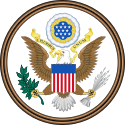Pieczęć stanowa Hawajów
Motto: Ua Mau ke Ea o ka ʻĀina i ka Pono znaczy w języku hawajskim Życie ziemi jest uwieczniane w prawości. Ustanowił je urzędnik pierwszego królestwa Kamehameha III, który w 1843 roku proklamował monarchię.
Na pieczęci widzimy dwie postaci: Z prawej (heraldycznie) strony Kamehameha Wielkiego, który zjednoczył Wyspy Hawajskie w jedno państwo. Po przeciwnej stronie znajduje się Bogini Wolności trzymająca flagę Hawajów.
Oboje trzymają tarczę herbową królestwa. Ponad nią wschodzące słońce z rokiem 1959 - datą przystąpienia do USA. Poniżej tarczy, umieszczono feniksa z wieńcem bananów i paproci.
Pierwsze i czwarte pole herbu przedstawia pasy reprezentujące osiem największych wysp. Każde z pól ma ich po cztery.
Drugie i trzecie pole przedstawia puloʻuloʻu (lokalny symbol władzy). W samym centrum umieszczono gwiazdę pięćdziesiątego z kolei stanu.
Herb Królestwa Hawajów
Herb wielki Królestwa Hawajów
Media użyte na tej stronie
Autor: Sodacan
| Ta ^specifik^ z W3C grafika wektorowa została stworzona za pomocą Inkscape. |
The Royal Coat of Arms of the Kingdom of Hawaii adopted in 1845 during the reigns of King Kamehameha III. In 1842 Timothy Haalilio, Private Secretary to the King, and Royal Advisor the Rev. William Richards commissioned the College of Arms in London to prepare a design. The design was modified slightly during the reign of King Kalākaua. The quartered shield has 1st and 4th quarters; the red, white and blue stripes representing the eight inhabited Hawaiian islands. The 2nd and 3rd quarters has two emblems of taboo (pulo'ulo'u) on yellow. The inescutcheon has crossed spears and the triangular flag on green. The shield in surmounted by the Crown of Hawaii. The dexter supporter represents Kamanawa holding a spear, the sinister Kameʻeiamoku holding a feather standard (kahili), twin brothers who were both high chiefs and the Counselors of State to King Kamehameha I. The motto reads: "Ua mau ke ea o ka ʻāina i ka pono" or "The life of the land is perpetuated in righteousness".
Autor: Sodacan, Licencja: CC BY-SA 3.0
The Royal Coat of Arms of the Kingdom of Hawaii adopted in 1845 during the reigns of King Kamehameha III. In 1842 Timothy Haalilio, Private Secretary to the King, and Royal Advisor the Rev. William Richards commissioned the College of Arms in London to prepare a design. The quartered shield has in its 1st and 4th quarters, the red, white and blue stripes representing the eight inhabited Hawaiian islands. The 2nd and 3rd quarters have two emblems of taboo (pulo'ulo'u) on yellow. The inescutcheon has crossed spears and the triangular flag on green. The shield in surmounted by the Crown of Hawaii. The dexter supporter represents Kamanawa holding a spear, the sinister Kameʻeiamoku holding a feather standard or kāhili, twin brothers who were both high chiefs and the Counselors of State to King Kamehameha I. The motto reads: "Ua mau ke ea o ka ʻāina i ka pono" or "The life of the land is perpetuated in righteousness".
The Great Seal of the State of Hawaii, in use from 1959 to the present day. Original design approved by Sanford B. Dole, the President of the Republic of Hawaii. Altered in 1901 to represent the change in status from republic to territory. Altered again in 1959 when the Legislature passed Act 272 (Regular Session of 1959).







